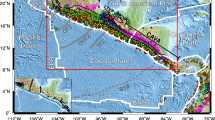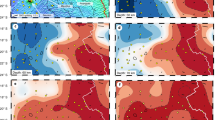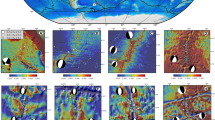Abstract
The volcanism responsible for creating the chain of the Hawaiian islands and seamounts is believed to mark the passage of the oceanic lithosphere over a mantle plume1,2. In this picture hot material rises from great depth within a fixed narrow conduit to the surface, penetrating the moving lithosphere3. Although a number of models describe possible plume–lithosphere interactions4, seismic imaging techniques have not had sufficient resolution to distinguish between them. Here we apply the S-wave ‘receiver function’ technique to data of three permanent seismic broadband stations on the Hawaiian islands, to map the thickness of the underlying lithosphere. We find that under Big Island the lithosphere is 100–110 km thick, as expected for an oceanic plate 90–100 million years old that is not modified by a plume. But the lithosphere thins gradually along the island chain to about 50–60 km below Kauai. The width of the thinning is about 300 km. In this zone, well within the larger-scale topographic swell, we infer that the rejuvenation model5 (where the plume thins the lithosphere) is operative; however, the larger-scale topographic swell is probably supported dynamically.
Similar content being viewed by others
Main
Thermomechanical processes caused by plume–lithosphere interactions have been studied for several decades. Various models have been proposed to explain the generating mechanism of the Hawaiian swell: (1) a model in which the dynamic pressure of the plume material flowing in the asthenosphere away from the plume centre supports the uplift of the sea floor4,6; (2) the thermal resetting (rejuvenation) model, in which the oceanic lithosphere is heated when it passes the hotspot, and thinning of the lithosphere causes isostatic uplift of the Hawaiian swell5; (3) a model in which extracted basaltic melt of the plume material underplates the base of the lithosphere. This residue of the plume material is compositionally lighter and has high seismic velocity7,8,9. Different models predict different seismic thicknesses of the lithosphere. In the first model, the lithospheric thickness along the swell is relatively stable. The second model (thermal rejuvenation) predicts a thinner lithosphere when it passes the hotspot. The lithospheric thickness in the third model will be larger than normal.
Until now, only the following observations of the lithospheric thickness by means of different seismic data have been available. In studies of surface-wave dispersion between Big Island and Oahu, a thickness of 88 km was suggested for a lithosphere 80–90 million years (Myr) old10. Between Oahu and Midway, 2,000 km northwest of Oahu, the average lithospheric thickness is estimated to be 100 km for a 50–110-Myr-old lithosphere11,12. In studies using converted waves, the thickness beneath Oahu was suggested to be 65–80 km (refs 13, 14), and 80 km southwest of Oahu15. From surface-wave dispersion data of an OBS (ocean bottom seismometer) array southwest of Oahu and Big Island, the average seismic structure of a 100-Myr-old oceanic lithosphere was derived and a significant velocity reduction at asthenospheric depths closer than 300 km to the island chain was found16. These facts are not sufficient to distinguish between competing models of lithosphere–plume interaction.
We have applied seismic techniques (S-receiver functions13,17,18) developed for P-receiver function studies to S-to-P converted waves (see Supplementary Information for a comparison of both techniques). S-receiver functions have been calculated from data of the permanent broadband stations POHA (IRIS/USGS), MAUI (GEOFON/ GeoForschungsZentrum, Potsdam) and KIP (IRIS/GEOSCOPE), which are located on the islands of Hawaii, Maui and Oahu, respectively. The locations of the stations POHA, MAUI and KIP and the piercing points of the S-to-P conversions at 100 km depth are shown in Fig. 1. Figure 2 shows the stacked S-receiver functions for a section NW–SE along the island chain (Fig. 2a) and a section SW–NE perpendicular to it (Fig. 2b). The sections are formed by stacking individual traces with piercing points at depths of 100 km within a window of length 30 km. Then the window is moved by 20 km for a new summation trace. Before summation, all traces were corrected for epicentral distance or slowness. A reference slowness of 6.4 s deg-1 has been chosen, similar to that in many P-receiver function studies, making P-to-S and S-to-P differential times directly comparable.
Piercing points of S-receiver functions at 100 km depth are shown (same symbols as stations). Two lines labelled NW–SE and SW–NE indicate the two sections shown in Fig. 2 onto which the S-receiver functions are projected. Section NW–SE is along the island chain while section SW–NE is perpendicular to the chain.
a, Along the island chain (NW–SE); b, perpendicular to it (SW–NE). Zero time corresponds to the S-wave arrival. The timescale is reversed. The stack bin is 30 km with 10 km overlap. Slowness (or distance) move-out corrections are applied (reference slowness of 6.4 s deg-1) before stacking. In section NW–SE (a) all S-to-P data are used that cover an up to 200-km broad sampling region at 100 km depth on each side of the section. In section SW–NE (b) only S–P data southeast of KIP (Oahu) are used. A 7–20 s bandpass filter is applied to suppress the noise. LAB indicates the lithosphere–asthenosphere boundary, which is a precursor of the S wave.
To suppress oceanic noise, a 7–20 s bandpass filter is applied. We reversed the polarity of amplitudes to compare the data directly with P-receiver functions. A clear negative phase (LAB, lithosphere–asthenosphere boundary) is identified in Fig. 2a, b. Negative (shaded) amplitudes are caused by velocity reduction downwards. To confirm that this phase is caused by the LAB, we compared the S-receiver functions with conventional P-receiver functions at the same stations and found good agreements (see Supplementary Information). The data in Fig. 2 are in the time domain. These delay times (in seconds) can roughly be converted into depth (in kilometres) by multiplying all times with a factor of 9, from the IASP91 model.
Figure 2a shows clearly that along the island chain the LAB thins from Big Island (12 s or 108 km depth at profile kilometre 500) to Kauai (6 s or 54 km depth at profile kilometre 0). Perpendicular to the island chain on the SW–NE section (Fig. 2b), the LAB is at 12 s delay time (108 km deep) at profile kilometres -150 to -100 and again at profile kilometre 200, northeast of the chain. It thins to 7–8 s (63–72 km deep) at profile kilometres 50–100 which is directly beneath the island chain along the profile (Fig. 1). The NW–SE section (Fig. 2a) contains all available S-to-P data. The perpendicular SW–NE section (Fig. 2b) contains only records with piercing points southeast of Oahu, which have similar minimum LAB depths. The two profiles in Fig. 2 indicate thinning of the lithosphere from Big Island to Oahu and Kauai as imaged in Fig. 3. The end of the thinning in the northwest direction is not visible. A station on Kauai or OBS stations northwest of Kauai would be necessary to follow the continuation of the lithospheric thinning.
We obtain from our observations the following picture of the plume–lithosphere interaction. Whereas the Pacific plate overrides the Hawaiian plume with a velocity of 7–8 cm yr-1, plume material hits the lithosphere and is dragged off. It spreads mainly in the direction of the plate motion and causes a long tail along the Hawaiian island chain. The bottom of the lithosphere is heated by the plume material from below and the increased temperature will reduce the velocity of elastic waves. In the vicinity of the present plume centre, only the lowest part of the lithosphere is heated and the lithospheric thickness does not change much with respect to that of a 90–100-Myr-old oceanic plate. As time increases, more and more material from the lower part of the lithosphere is warmed up and the seismic LAB becomes shallower. After 3–4 Myr of heating time the thinnest lithosphere of 50–60 km is achieved beneath Oahu and Kauai—a location about 400 km away from the current plume centre10. Further away, at Midway Island, which passed the plume centre about 28 Myr ago, the plume material begins to lose its temperature and the lithosphere thickens again11,12.
We conclude that the Hawaiian plume has gradually reheated up to 50 km of the lower lithosphere within the last 3–4 Myr in an area of 500 × 300 km along the island chain. This means that a substantial amount of heat is trapped below the lithosphere. The lateral extent of the asthenospheric updoming is significantly smaller than the extent of the Hawaiian topographic swell. A consequence of our result could be that the entire topographic swell is caused by, for example, the dynamic support of the plume, and so rejuvenation would be contributing only in the central part. Data from longer-term broadband stations on Kauai, and on the ocean bottom northwest of Kauai, could permit imaging of the ‘re-ageing’ of the rejuvenated Hawaiian lithosphere.
References
Wilson, J. T. A possible origin of the Hawaiian island. Can. J. Phys. 41, 863–868 (1963)
Morgan, W. J. Convective plumes in the lower mantle. Nature 230, 42–43 (1971)
Nataf, H.-C. Seismic imaging of mantle plumes. Annu. Rev. Earth Planet. Sci. 28, 391–417 (2000)
Ribe, N. M. & Christensen, U. R. The dynamical origin of the Hawaiian volcanism. Earth Planet. Sci. Lett. 171, 517–531 (1999)
Detrick, R. S. & Crough, S. T. Island subsidence, hot spots, and lithospheric thinning. J. Geophys. Res. 83, 1236–1244 (1978)
Sleep, N. H. Hotspots and mantle plumes: Some phenomenology. J. Geophys. Res. 95, 6715–6736 (1990)
Jordan, T. H. in The Mantle Sample: Inclusions in Kimberlites and Other Volcanics (eds Boyd, F. R. & Meyer, H. O. A.) 1–14 (Proc. 2nd Int. Kimberlite Conference, American Geophysical Union, 1979)
Robinson, E. M. The topographic and gravitational expression of density anomalies due to melt extraction in the uppermost oceanic mantle. Earth Planet. Sci. Lett. 90, 221–228 (1988)
Phipps Morgan, J., Morgan, W. J., Zhang, Y.-S. & Smith, W. H. F. Observational hints for a plume-fed, suboceanic asthenosphere and its role in mantle convection. J. Geophys. Res. 100, 12753–12767 (1995)
Priestley, K. & Tilmann, F. Shear-wave structure of the lithosphere above the Hawaiian hot spot from two-station rayleigh wave phase velocity measurements. Geophys. Res. Lett. 26, 1493–1496 (1999)
Woods, M., Leveque, J. J. & Okal, E. A. Two-station measurements of Rayleigh wave group velocity along the Hawaiian swell. Geophys. Res. Lett. 18, 105–108 (1991)
Woods, M. T. & Okal, E. A. Rayleigh-wave dispersion along the Hawaiian Swell: a test of lithospheric thinning by the thermal rejuvenation at a hotspot. Geophys. J. Int. 125, 325–339 (1996)
Bock, G. Long-period S to P converted waves and the onset of partial melting beneath Oahu, Hawaii. Geophys. Res. Lett. 18, 869–872 (1991)
Li, X. et al. Mapping the Hawaiian plume with converted seismic waves. Nature 405, 938–941 (2000)
Collins, J. A., Vernon, F. L., Orcutt, J. A. & Stephen, R. A. Upper mantle structure beneath the Hawaiian swell: constraints from the ocean seismic network pilot experiment. Geophys. Res. Lett. 29, doi: 101029/2001GL013302 (2002)
Laske, G., Phipps Morgan, J. & Orcutt, J. A. First results from the Hawaiian SWELL pilot experiment. Geophys. Res. Lett. 26, 3397–3400 (1999)
Faber, S. & Müller, G. Sp phases from the transition zone between the upper and lower mantle. Bull. Seismol. Soc. Am. 70, 487–508 (1980)
Farra, V. & Vinnik, L. Upper mantle stratification by P and S receiver functions. Geophys. J. Int. 141, 699–712 (2000)
Acknowledgements
We thank G. Asch and J. Mechie for their aid. We also thank the people of the Kaleahala National Park for supporting our station MAUI. This work has been supported by the Deutsche Forschungsgemeinschaft within the ICDP project and by the GeoForschungsZentrum, Potsdam. Waveform data have been provided by the IRIS, GEOSCOPE and GEOFON data centres.
Author information
Authors and Affiliations
Corresponding author
Ethics declarations
Competing interests
The authors declare that they have no competing financial interests.
Supplementary information
Rights and permissions
About this article
Cite this article
Li, X., Kind, R., Yuan, X. et al. Rejuvenation of the lithosphere by the Hawaiian plume. Nature 427, 827–829 (2004). https://doi.org/10.1038/nature02349
Received:
Accepted:
Issue Date:
DOI: https://doi.org/10.1038/nature02349
This article is cited by
-
Thermal ages of the Huatung Basin determined from seismic waveform modeling: insights into Southeast Asia’s evolution
Scientific Reports (2023)
-
Genesis of Hawaiian lavas by crystallization of picritic magma in the deep mantle
Nature Communications (2023)
-
Modeling and assessment of CO2 geological storage in the Eastern Deccan Basalt of India
Environmental Science and Pollution Research (2022)
-
Deep continental roots and cratons
Nature (2021)
-
Discovery of flat seismic reflections in the mantle beneath the young Juan de Fuca Plate
Nature Communications (2020)
Comments
By submitting a comment you agree to abide by our Terms and Community Guidelines. If you find something abusive or that does not comply with our terms or guidelines please flag it as inappropriate.






